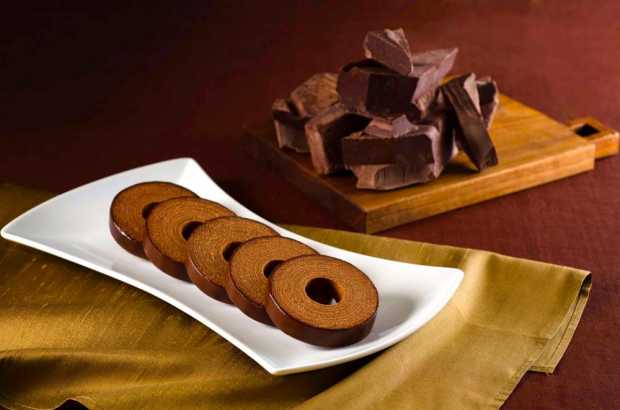Not a member yet? Sign Up!
Info
Please use real email address to activate your registration

A gift box with Japanese style packaging arrived on our door marked Juchheim. Inside was an orange box containing a delicate baumkuchen (tree ring cake).
Its chocolaty, not too sweet taste, moist and fluffy texture made us want to keep consuming it and wondered about this special cake.
Centuries-old recipe
Baumkuchen has centuries of history to trace back. It began in Ancient Greece and then Rome. When the Romans ruled Northern Europe, they brought the recipe for baking cakes on logs over an open fire to modern day Germany and the surrounding regions. A written record shows a recipe of baumkuchen in a German cookbook published in 1581.
Using a special oven, bakers drip the cake batter onto a rotating spit that turns and allows the cake to cook slowly and evenly. Once the layer turns light brown in color, another layer of batter is brushed on top of that. The process repeats until about 15 to 20 layers and the cake is covered with thick chocolate, marmalade or sugar.
 Photo: Juchheim
Photo: Juchheim
Juchheim's baumkuchen
Last month when we visited Yokohama, we saw baumkuchen of small sizes sold in Family Marts all over the city. Apparently baumkuchen, especially Juchheim’s baumkuchen is legendary and available all over Japan.
Karl Juchheim, a German prisoner of the First World War, who in 1929 opened a pastry shop with his wife in Yokohama, first introduced the cake. The company has since been producing baumkuchen using eggs, sugar, butter and wheat flour as the main ingredients. The secret is whisking the egg yolk and egg white separately. The creaming nature of the egg yolk and the foaminess of the egg white produce a soft and fluffy batter.
 Photo: Juchheim
Photo: Juchheim
 Photo: Juchheim
Photo: Juchheim
Machine and home made
Making baumkuchen is a tedious process that takes hours to finish. Schlee GmbH, a German company, manufactures baumkuchen machines for different sizes of rolls. To use Schlee machine, bakers put the batter in a rectangular shape pan. The spit is then dipped into the batter and cooked, layer by layer.
Paul Gauweiler a German born baker in Huntington Beach, California uses baumkuchen machine. He prefers a traditional batter with a 30-egg formula: 1 pound of butter, 1 pound of sugar, 1 pound of flour and 30 eggs.
 Photo: Schlee GmbH
Photo: Schlee GmbH
 Photo: Global Table Adventure
Photo: Global Table Adventure
Those who are interested in making baumkuchen at home, can visit the Global Table Adventure website created by Sasha Martin who cooked 195 meals of 195 counties in 195 weeks. Sasha who made 20 layers of baumkuchen says you need two days to make this cake because the cake needs to chill in the fridge overnight.
The iFoodTv has identified this kind of cake in several European countries. In Austria it is known as Prügelkrapfen and is usually served as snack. In Poland it is called Sekacz and is popular in Polish cuisine. In Hungary the cake, also cooked on a spit, is called KürtÅ‘skalács In Luxembourg, the cake is called Baamkuch and is prepared for wedding ceremonies and other celebrations.
 Photo: Choo Poh Guan/123rf
Photo: Choo Poh Guan/123rf
Indonesia's baumkuchen
An Indonesian version of baumkuchen is lapis legit (delicious layered cake). Lapis legit is a modified version of spekkoek, a Dutch layered cake,but with a heavier texture and a tint of exotic spices in its taste due to cinnamon, cardamom, clove, and nutmeg. Lapis legit is almost always present during the Eid, Christmas, and New Year celebrations in Indonesia.
Photo: Elvis untot
Baumkuchen, however is most popular in Japan. It is a welcome gift for friend, family of lover. In addition to overseas stores in Hongkong, Singapore and Shanghai, Juchheim has more than 350 stores in Japan.
---------------------------
Images:
Cover photo by Juchheim. All others by Omar Niode Foundation, unless otherwise noted.